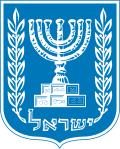Embassy of Israel, Tehran
Israel's political representation in Iran, also referred to as the Embassy of Israel in Tehran (Hebrew: שגרירות מדינת ישראל טהראן), was a large three-story building on Kakh Boulevard (now Palestine Street) in the capital of Iran, that was owned by the Israeli diplomatic mission.[1] Embassy of Israel in Tehran, was the diplomatic mission of Israel in Iran when Iran and Israel had diplomatic relations from 1948 to 1979, the year of the Iranian revolution.[2][3] This agency was active in Tehran since 1960 and until a few days before February 11, 1979, but after the fall of the Pahlavi dynasty and the victory of the Iranian revolution, it was attacked by the revolutionaries and was handed over to Palestinian guerillas who were members of the Palestine Liberation Organization by installing the Palestinian flag.[4] Following the visit of Yasser Arafat, the leader of the Fatah movement, to Tehran on February 17, 1979, that is, exactly 6 days after the victory of the Iranian revolution, the sign "Embassy of Palestine" was installed on top of the political representation of Israel, and two days later, on February 19, Yasser Arafat along with Ahmad Khomeini and Ebrahim Yazdi, attended the former Israeli embassy and opened the Palestinian embassy in Tehran.[5] Also, the names of Kakh Street and Kakh Square were changed to Palestine Street and Palestine Square, respectively. HistoryDuring the reign of Mohammed Reza Shah, Iran became the second Muslim country after Turkey to recognize Israel.[6] But after the Iranian Islamic revolution of 1979, the Israel embassy in Iran was closed. After that, Iran never recognized Israel.[7][8] Zvi Duriel was the first ambassador of Israel's political representation in Iran.[9][10] During the 5-year embassy of Israel's plenipotentiary representative in Tehran, with ambassador Uri Lubrani between 1974 and 1979, many Israeli officials visited Iran many times, such as Yitzhak Rabin, Yigal Allon, Moshe Dayan and Shimon Peres.[11] Yossef Harmelin, the former head of Israel's internal security agency (Shin Bet), was the last plenipotentiary representative of Israel in Tehran, whose term as ambassador in Tehran ended with the victory of the Iranian Islamic revolution of 1979.[12] Finally, on February 18 1979, the Israeli ambassador, Yossef Harmelin, and the embassy staff fled the country.[13] The Palestine Liberation Organization (PLO) backed the 1979 Iranian revolution, and several days after the revolution, PLO chief Yasser Arafat led a Palestinian delegation to Iran. The Palestinian delegates were publicly welcomed, and symbolically handed the keys to the former Israeli embassy in Tehran, which later became a Palestinian embassy.[14] Hani al-Hassan, one of the key diplomatic figures of the PLO, was appointed as the first ambassador of Palestine to Iran.[15] Cultural relationsBefore the 1979 revolution in Iran, the two countries of Iran and Israel had close but informal relations with each other, which went beyond economic and commercial relations. According to the archives of the Israeli Ministry of Foreign Affairs, during that period, more than 500 Israeli families lived in Iran, and Israeli students which living in Tehran, went to a Hebrew language school under the supervision of the Israeli Ministry of Education, which was managed by the Israeli political representation in Tehran.[16] In 1962, Jalal Al-e-Ahmad, a famous Iranian author, traveled to Israel for two weeks and published a travelogue of his experience.[17] The expenses of this trip were covered by the political representation of Israel in Tehran.[18] List of ambassadorsFrom 1948 to 1979, when the Israeli embassy was operating in Iran, the following people were appointed as ambassadors:[19][20][21]
See also
References
|
||||||||||||||
Portal di Ensiklopedia Dunia














